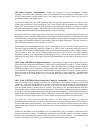26
15. MEASURING A TRANSMITTER’S SPURIOUS EMISSIONS
15.1 General – One consideration when working on older or homebrew transmitters is maintaining low
spurious emissions. These should be as low as possible, usually down–30db or more from the transmitter’s
carriers or maximum output level. The HP3586 has an excellent capability for searching for and measuring
spurious emissions, as the following examples will show.
With plate modulated AM transmitters the spurious HF emissions are usually harmonics of it’s carrier
frequency, sub-harmonics from signals leaking through from exciter’s multiplier stages, and out of band
emissions near its carrier frequency caused by non linearity or improper operation of it’s modulated stage.
With SSB transmitter there can be the harmonics of its tuned frequency, emissions at other frequencies
used within the transmitter, along with the wide band emissions around it’s tuned frequency usually caused
by improper modulation. In the following sections we will first show an example for a 100 watt AM
transmitter than one for a 100 watt SSB transmitter.
Unfortunately, if we want to look at the harmonics up to the third harmonic, the maximum carrier
frequency we could use is just over 10MHz since the instrument’s frequency response is good only up to
32MHz.
15.2 Setup – We first put a resistor divider network on the input to a 50 ohm 100 watt dummy transmitter
load in a manner similar to the one we used for our amplifier wide band noise measurements. One thing
we want to be very careful of is the following:
Never put more than +27dbm or .5 watts total power into the input 50 ohm or 75 ohm connector of a
HP3586 when using the internal termination. Never put more than +42 volts total AC + DC into an
unterminated connector.
To attenuate the 70volts RMS 100 watt signal on the 50 ohm dummy load down to .27 volts, about 1 mw
across the instrument’s 75 ohm termination, we calculate that a series 26K ohm resistor between the
dummy load and the 75 ohm terminated input of our HP3586 should accomplish this. Since we want to
cover up to 30MHz of frequency, we put the dummy load as close as possible to the HP3586 and run a
coax line to the AM or SSB transmitter’s output.
Place the HP3586 into the selective low distortion or carrier measurement mode for this measurement and
select units of dbm.
15.2 AM Transmitter’s Measurement Procedure – We start by slowly tuning up our transmitter at
1/4 power, half voltage half plate current like most AM transmitters have the ability to do. Now watch the
LED level meter on our HP3586 reading in dbm. It should be around –6dbm +/- 3db indicating about ¼
mw. If it isn’t adjust the 26K resistor to get near to this instrument display level. Now we tune to full
carrier power and should see around 0dbm, say +2.01 dbm, which is fine for our use. Now normalize this
reading to 0db using the same offset procedure of our previous examples in section 14.3 of Chapter 14.
AM transmitters usually put out some harmonic and can put out sub harmonics depending on their exciter
stage design. As we did in the audio amp harmonic measurements, look at twice three times the carrier
frequency of the 2
nd
and 3
rd
harmonics, the 4
th
and higher ones are usually very much lower if the 2
nd
and
3
rd
are low. Use the same procedure of locking onto the harmonics using the counter as in Chapter 14. Say
we find the 2
nd
is down –45db and the 3
rd
is down- 70db. This looks fine. Now tune to ½ and 1/3 or even
¼ of the carrier frequency and look for spurious signals. Don’t be surprised if you find something leaking
through from the transmitter’s exciter stages, but it should be down at least –50db in a well designed AM
transmitter.


















